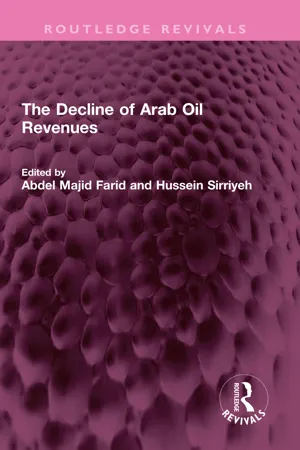
- 310 pages
- English
- ePUB (mobile friendly)
- Available on iOS & Android
The Decline of Arab Oil Revenues
About This Book
First published in 1986, The Decline of Arab Oil Revenues explores the fall in the economic value of Arab oil reserves in the 1980s. Some of the threats to Arab countries include depletion of oil resources, rise of alternative sources of energy, international policies designed to control oil prices and growing conflicts of interest between producing and consuming countries. The editors suggest that any decline in oil revenues would negatively affect the economic, political, social and psychological structure of Arab societies since they are yet to explore non-oil sources of wealth. Consequently, the editors stress on the importance of researching the desert, which covers 94% of Arab lands, as a potential source of wealth. Given the current global shift towards sustainable forms of energy, this book is a timely reminder of the economic and political implications of such a shift on Arab countries for students of political science, international relations, geography, and economics.
Frequently asked questions
Information
1 Decline in Arab Oil Revenues
Regional Characteristics
1. All countries presently members of OPEC. The oil resources of these countries will continue, for several years, to exceed their own needs. They may be further subdivided into two subgroups:a. Algeria and Iraq, which have a large hydrocarbons sector but at the same time possess other natural resources, as well as sizeable human resources.b. Those countries whose major resource is oil but which lack other natural resources. Most of its members also suffer from scarcity of manpower. They include Libya and the four Gulf states of Kuwait, Qatar, Saudi Arabia and the United Arab Emirates (UAE).2. Countries with greater balance between oil resources and needs, which are expected to run out of oil resources in the near future. They include Oman, and the other members of the Arab group within OPEC (OAPEC), Bahrain, Egypt, Syria and Tunisia.3. Countries which may have limited oil resources but are essentially importers of oil and its products.a. A middle-income group comprising Jordan, Lebanon and Morocco.b. Less developed countries including Djibouti, Somalia, Sudan and the two Yemens.
Table of contents
- Cover
- Half Title
- Title
- Copyright
- Original Title
- Original Copyright
- Contents
- List of Contributors
- Preface
- 1. Decline in Arab Oil Revenues
- 2. Prospects for Arab Oil Revenues
- 3. Factors Affecting Demand for Arab Oil
- 4. Alternative Sources of Energy
- 5. Political and Strategic Impact on Arab Relations with Industrialised Countries
- 6. Impact on Arab Economic Relations with Advanced Capitalist States and Developing Countries
- 7. Social and Psychological Impact on the Arab World
- 8. Social Tension in the Arab World in the Post-oil Era
- 9. Economic Impact on Arab Relations with the Third World
- 10. Political, Strategic and Economic Effects on Arab Relations with the Third World
- 11. Economic Impact on the Arab World
- 12. Economic Impact on Development in Arab Countries
- 13. Comments on the Economic Symposium Papers Given
- 14. Conclusions and Recommendations
- Appendix 1: Energy and Economic Statistics in the Arab World
- Appendix 2: Prominent Issues Discussed at the Third Arab Energy Conference, Algeria, May 1985
- Index